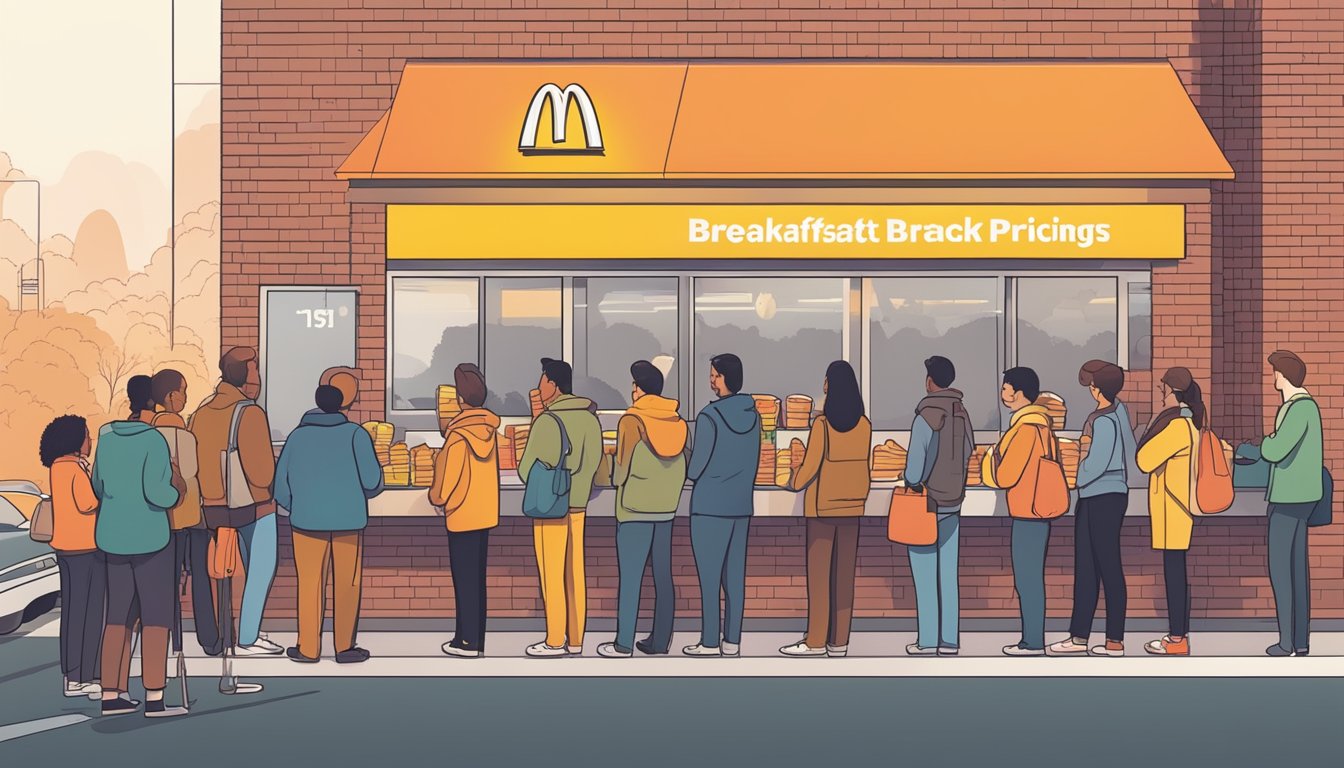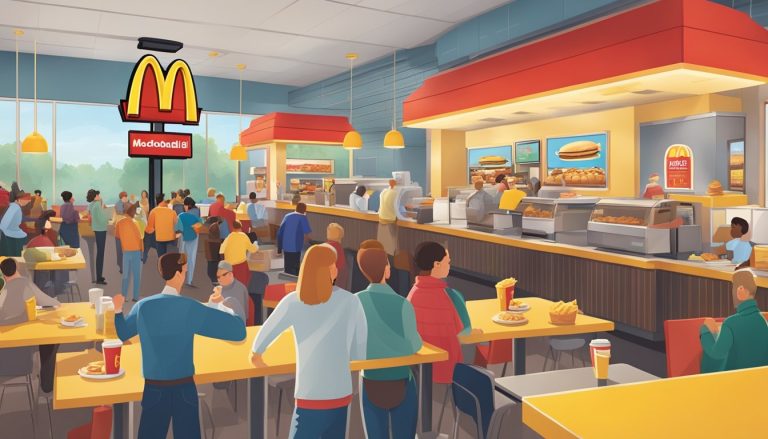McDonald’s breakfast pricing strategy is a crucial component of its overall business model, designed to attract customers during morning hours and maximize profitability. The fast-food giant employs a dynamic approach, carefully balancing affordability with market demand and operational costs. By offering a mix of value items and premium options, McDonald’s aims to cater to diverse customer preferences while maintaining competitive pricing in the breakfast segment.
This strategy extends beyond simple cost-plus pricing, incorporating sophisticated data analysis and localized market insights. McDonald’s leverages its vast network of restaurants to gather real-time information on customer behavior, allowing for rapid adjustments to pricing and menu offerings. The company’s breakfast pricing also reflects its commitment to innovation, regularly introducing new items to keep the menu fresh and appealing to changing consumer tastes.
A business analysis of McDonald’s breakfast pricing reveals a complex interplay of factors, including supply chain efficiency, brand positioning, and competitive landscape. The success of this strategy is evident in the steady stream of morning customers and the significant contribution of breakfast sales to the company’s overall revenue. As McDonald’s continues to refine its approach, the breakfast menu remains a key battleground in the fast-food industry’s ongoing price wars.
McDonald’s Corporation Overview

McDonald’s Corporation stands as a pivotal player in the global fast food industry. Its iconic golden arches symbolize a business empire built on efficiency, consistency, and widespread appeal.
Historical Context and Development
Ray Kroc founded McDonald’s Corporation in 1955, transforming a small California hamburger stand into a worldwide phenomenon. Kroc’s vision centered on a standardized menu, quick service, and affordable prices. This model revolutionized the fast food landscape.
The company introduced its first drive-thru in 1975, further enhancing convenience. McDonald’s menu evolved over time, adding breakfast items in the 1970s and healthier options in recent decades. The Happy Meal, launched in 1979, became a marketing masterpiece, cementing McDonald’s appeal to families.
Key Business Operations
McDonald’s operates on a franchise model, with over 90% of its restaurants run by independent franchisees. This structure allows for rapid expansion while maintaining brand consistency.
The company’s supply chain management is a cornerstone of its success. McDonald’s works closely with suppliers to ensure quality and cost-effectiveness. Its “3-legged stool” philosophy emphasizes balance between franchisees, suppliers, and corporate employees.
McDonald’s focuses on menu innovation, digital ordering systems, and delivery services to stay competitive. The company also invests heavily in marketing and advertising to maintain brand awareness.
Global Presence and Market Share
McDonald’s boasts an impressive global footprint, serving millions of customers daily across more than 100 countries. As of 2025, the company operates over 40,000 restaurants worldwide.
In the United States, McDonald’s holds the largest market share in the fast food burger segment. Internationally, the company adapts its menu to local tastes while maintaining core offerings.
McDonald’s faces stiff competition from other fast food chains and changing consumer preferences. However, its brand recognition and established infrastructure continue to drive its market dominance.
Breakfast Menu Offerings
McDonald’s breakfast menu features a diverse array of products designed to cater to various customer preferences. The offerings include classic favorites, premium coffee options, and limited-time specials.
Core Breakfast Products
McDonald’s breakfast lineup centers around several key items. The Egg McMuffin, introduced in 1972, remains a flagship product. It consists of a toasted English muffin, Canadian bacon, a fresh egg, and American cheese.
Other popular choices include:
- Sausage McMuffin with Egg
- Bacon, Egg & Cheese Biscuit
- Hotcakes with Sausage
- Hash Browns
These core items form the foundation of McDonald’s breakfast menu, offering familiar flavors that customers rely on.
McCafé Line Expansion
The McCafé brand has significantly enhanced McDonald’s breakfast beverage offerings. Launched in 2009, it brought premium coffee drinks to the menu.
Key McCafé products include:
- Premium Roast Coffee
- Cappuccino
- Latte
- Mocha
- Iced Coffee
These beverages compete directly with specialty coffee shops, positioning McDonald’s as a more affordable alternative for quality coffee drinks.
Seasonal and Limited-Time Offers
McDonald’s regularly introduces seasonal and limited-time breakfast items to maintain customer interest. These offerings often align with holidays or cultural events.
Examples include:
- Donut Sticks (introduced in 2019)
- Pumpkin Spice Latte (fall seasonal item)
- Shamrock Shake (St. Patrick’s Day)
These temporary additions create buzz and drive traffic during specific periods. They also allow McDonald’s to test new products and gauge customer interest for potential permanent menu inclusion.
Pricing Strategy Exposition
McDonald’s employs a multi-faceted approach to pricing that balances affordability with profitability. The company leverages various pricing techniques to attract customers while maximizing revenue across different market segments and product offerings.
Value Pricing and Affordability
McDonald’s prioritizes value pricing to maintain its competitive edge in the fast-food industry. The company focuses on keeping prices low enough to appeal to budget-conscious consumers while still delivering quality products. This strategy aligns with their “Think Global, Act Local” approach, allowing for price adjustments based on local economic conditions and consumer purchasing power.
McDonald’s Dollar Menu exemplifies this value-oriented pricing. It offers select items at a fixed low price point, attracting cost-sensitive customers and driving foot traffic. The company also regularly introduces limited-time promotions and discounts to reinforce its image as an affordable dining option.
In international markets, McDonald’s adapts its pricing to local income levels and competitors’ offerings. This flexibility ensures that the brand remains accessible to a wide range of consumers across diverse economic landscapes.
Bundle Pricing Approaches
McDonald’s effectively utilizes bundle pricing to increase average transaction values and provide perceived value to customers. The iconic combo meals combine main items, sides, and drinks at a slightly discounted price compared to purchasing items separately.
Value Meals are a cornerstone of this strategy, offering popular combinations like Big Mac, fries, and a drink. These bundles simplify the ordering process and create a sense of savings for customers. McDonald’s also introduces limited-time bundle offers to drive sales of new or underperforming menu items.
Family Meals and Share Boxes extend the bundle concept to larger groups, encouraging higher-volume purchases. These options are particularly effective for drive-thru and takeout orders, catering to families and social gatherings.
Psychological Pricing Implications
McDonald’s employs psychological pricing tactics to influence consumer perceptions and decision-making. The use of prices ending in .99 is common, creating the illusion that items are more affordable than they actually are.
The company strategically positions premium items alongside value options on menus. This contrast effect makes mid-range items appear more attractive, often leading customers to choose options that offer a balance between price and perceived quality.
McDonald’s also uses anchor pricing by introducing higher-priced limited-time offerings. These items can make regular menu prices seem more reasonable by comparison, potentially increasing overall sales.
Dynamic Pricing Innovation
McDonald’s is exploring dynamic pricing strategies to optimize revenue and manage demand fluctuations. Digital menu boards in drive-thrus allow for real-time price adjustments based on factors like time of day, weather conditions, and local events.
The company’s mobile app enables personalized pricing through targeted promotions and loyalty rewards. This data-driven approach allows McDonald’s to offer individualized discounts that maximize customer value while protecting profit margins.
McDonald’s is testing AI-powered pricing algorithms that analyze vast amounts of data to predict demand and set optimal prices. This technology promises to enhance the company’s ability to respond quickly to market changes and consumer behavior shifts.
Marketing Mix and Promotions
McDonald’s employs a comprehensive marketing approach to promote its breakfast offerings and maintain its position as a leading fast-food chain. The company utilizes various strategies across different channels to reach and engage customers effectively.
4Ps of McDonald’s Marketing
McDonald’s marketing mix consists of product, price, place, and promotion. The product lineup includes popular breakfast items like Egg McMuffins and hotcakes. Prices are set competitively to appeal to value-conscious consumers.
McDonald’s extensive restaurant network ensures wide availability. Drive-thrus and mobile ordering enhance convenience. The company’s promotion efforts span traditional and digital media channels.
McDonald’s adapts its marketing mix to local preferences and market conditions. This flexibility allows the company to maintain relevance across diverse global markets.
Advertising and Public Relations
Television commercials remain a key component of McDonald’s advertising strategy. The company invests heavily in prime-time slots to showcase its breakfast menu.
Print ads and billboards supplement TV campaigns, reinforcing brand visibility. McDonald’s also sponsors major sporting events and partners with popular franchises to boost brand awareness.
Public relations initiatives focus on addressing health concerns and promoting corporate social responsibility. The company highlights its use of fresh ingredients and efforts to improve nutritional value.
Social Media and Direct Marketing
McDonald’s leverages social media platforms to engage customers and promote breakfast offerings. The company maintains active accounts on Facebook, Twitter, and Instagram.
User-generated content and influencer partnerships help create buzz around new menu items. McDonald’s also uses targeted email campaigns to deliver personalized offers to loyalty program members.
The McDonald’s mobile app serves as a direct marketing channel, providing exclusive deals and convenient ordering options. Push notifications remind users about breakfast promotions and limited-time offers.
Sales Promotions and Special Deals
McDonald’s frequently runs sales promotions to drive breakfast traffic. Common tactics include:
- Buy-one-get-one-free offers
- Discounted combo meals
- Limited-time menu items
The company’s loyalty program, MyMcDonald’s Rewards, incentivizes repeat purchases through point accumulation. Members can redeem points for free menu items, including breakfast favorites.
Seasonal promotions, such as holiday-themed menu items, create urgency and encourage customers to visit during specific periods. McDonald’s also partners with other brands for cross-promotional deals to attract new customers.
Competitive Strategies
McDonald’s employs various competitive strategies to maintain its position as a leading fast-food chain. These strategies focus on differentiation, cost leadership, expansion, and customer retention.
Market Differentiation Tactics
McDonald’s sets itself apart through menu innovation and localization. The company regularly introduces new items tailored to regional tastes and preferences. In India, for example, McDonald’s offers the McAloo Tikki burger, while in Japan, customers can enjoy the Teriyaki McBurger.
McDonald’s also differentiates itself through its breakfast menu. The company was one of the first fast-food chains to offer breakfast items on a large scale. Its Egg McMuffin and hash browns have become iconic breakfast options.
To appeal to health-conscious consumers, McDonald’s has introduced salads, wraps, and fruit options. This strategy helps the company attract a broader customer base and compete with healthier fast-casual restaurants.
Cost Leadership Model
McDonald’s maintains a strong cost leadership position through economies of scale and efficient operations. The company’s massive purchasing power allows it to negotiate favorable prices with suppliers, reducing ingredient costs.
Standardized processes and equipment across locations ensure consistent quality and minimize training costs. This efficiency enables McDonald’s to offer competitive prices while maintaining profitability.
The company also invests in technology to reduce labor costs and improve efficiency. Self-service kiosks and mobile ordering apps streamline the ordering process and reduce the need for front-counter staff.
Franchising and Diversification
Franchising is a key growth strategy for McDonald’s. By franchising, the company can expand rapidly with minimal capital investment. Franchisees bring local market knowledge and entrepreneurial spirit to the business.
McDonald’s diversifies its revenue streams through various initiatives. The company has expanded into coffee shops with McCafé, offering premium coffee drinks and pastries. This move allows McDonald’s to compete with specialty coffee chains and capture a share of the growing coffee market.
The company has also diversified its real estate holdings. McDonald’s owns many of the properties where its restaurants operate, generating rental income from franchisees.
Customer Loyalty and Quality Service
McDonald’s focuses on building customer loyalty through consistent quality and service. The company’s “Quality, Service, Cleanliness, and Value” (QSC&V) philosophy guides its operations and customer interactions.
To enhance customer experience, McDonald’s has implemented digital initiatives like mobile apps and loyalty programs. The McDonald’s app offers exclusive deals and rewards points, encouraging repeat visits and increasing customer engagement.
The company also invests in staff training to ensure courteous and efficient service. McDonald’s Hamburger University provides comprehensive training for restaurant managers and franchisees, maintaining service standards across the globe.
Operations Management
McDonald’s operations management focuses on efficiency, technology integration, and streamlined service delivery. The company leverages various strategies to maintain its competitive edge in the fast food industry.
Supply Chain Efficiencies
McDonald’s optimizes its supply chain through strategic partnerships and economies of scale. The company works closely with suppliers to ensure consistent quality and timely delivery of ingredients.
McDonald’s uses a centralized distribution system, allowing for bulk purchasing and reduced costs. This system enables the company to maintain uniform standards across its global network of restaurants.
The company also implements just-in-time inventory management to minimize waste and storage costs. This approach ensures fresh ingredients are always available while reducing overhead expenses.
Digital Integrations and Kiosks
McDonald’s has embraced digital technology to enhance customer experience and streamline operations. Self-service kiosks have been installed in many locations, reducing wait times and labor costs.
These kiosks allow customers to customize orders easily, potentially increasing average ticket size. The digital interface also enables McDonald’s to quickly update menu items and pricing.
Mobile ordering and payment options further integrate technology into the customer experience. This system reduces order errors and speeds up service, particularly during peak hours.
Delivery Capabilities and Drive-Thru
McDonald’s has expanded its delivery capabilities through partnerships with third-party services like Uber Eats and DoorDash. This move broadens the company’s customer base and increases sales potential.
The company continually optimizes its drive-thru operations, a crucial component of its business model. Advanced ordering systems and dedicated lanes for mobile orders help reduce wait times.
McDonald’s also utilizes data analytics to improve drive-thru efficiency. By analyzing traffic patterns and order trends, the company can adjust staffing and streamline menu offerings during peak periods.
Customer Engagement Strategy
McDonald’s breakfast pricing strategy is complemented by robust customer engagement initiatives. These efforts focus on gathering feedback, enhancing the dining experience, and fostering community connections.
Leveraging Customer Feedback
McDonald’s actively solicits customer opinions to refine its breakfast offerings. The company uses surveys, social media monitoring, and in-store feedback kiosks to gather insights. This data informs menu adjustments, pricing decisions, and service improvements.
Customer feedback led to the introduction of all-day breakfast in many markets. It also influenced the expansion of healthier options like fruit and yogurt parfaits. McDonald’s regularly updates its mobile app based on user suggestions, enhancing the ordering experience.
Upselling and Customization
McDonald’s trains staff to suggest additional items or upgrades during breakfast orders. This upselling technique often focuses on pairing coffee with food items or recommending larger meal combos.
The company’s digital kiosks and mobile app allow customers to customize their breakfast orders easily. Options include removing ingredients, adding extras, or swapping items in meal deals. This flexibility caters to individual preferences and dietary needs.
McDonald’s also uses data analytics to personalize offers and promotions for frequent customers, encouraging repeat visits during breakfast hours.
Community Engagement and Charity
McDonald’s strengthens customer relationships through local community involvement. Many franchises sponsor school breakfast programs or donate to food banks.
The Ronald McDonald House Charities (RMHC) is a key part of the company’s charitable efforts. Some locations donate a portion of breakfast sales to RMHC on specific days.
McDonald’s often hosts community events like “Coffee with a Cop” during breakfast hours. These initiatives foster positive relationships with local residents and organizations, enhancing the brand’s reputation beyond its food offerings.
Analysis of Financial Performance
McDonald’s breakfast pricing strategy has significantly impacted its financial performance. The breakfast segment contributes substantially to revenue growth, profitability, and market position.
Revenue Impact of Breakfast Segment
McDonald’s breakfast offerings have become a major revenue driver. The company’s all-day breakfast initiative, launched in 2015, boosted sales by 5.7% in the first quarter after implementation. Breakfast items now account for approximately 25% of McDonald’s total sales.
The pricing strategy for breakfast items varies by market and product. Premium items like the Egg McMuffin are priced higher, while value menu options attract budget-conscious customers. This tiered pricing approach has helped McDonald’s capture a wider customer base and increase overall breakfast revenue.
Cost versus Profit Analysis
The breakfast segment typically has lower food costs compared to lunch and dinner items. Eggs, bacon, and bread are relatively inexpensive ingredients, allowing for higher profit margins. However, labor costs can be higher during breakfast hours due to the need for specialized preparation.
McDonald’s has optimized its breakfast menu to balance profitability and customer appeal. The company has:
- Streamlined breakfast operations to reduce labor costs
- Introduced higher-margin items like McCafé beverages
- Utilized dynamic pricing to maximize revenue during peak breakfast hours
These strategies have helped maintain strong profit margins in the breakfast segment.
Investor and Market Considerations
McDonald’s breakfast strategy has positively impacted its stock performance and market share. The company’s focus on breakfast has:
- Increased same-store sales growth
- Improved overall financial metrics
- Strengthened its competitive position against rivals like Starbucks and Dunkin’
Investors have responded favorably to McDonald’s breakfast initiatives. The company’s stock price has shown consistent growth, with a 20% increase over the past year. Analysts attribute part of this success to the strong performance of the breakfast segment.
McDonald’s currently holds a 17% market share in the fast-food breakfast category, leading its competitors. This dominant position has helped the company maintain its status as a blue-chip stock and attract long-term investors.
Strategic Frameworks Application
McDonald’s employs various strategic frameworks to analyze and optimize its breakfast pricing strategy. These tools provide valuable insights into growth opportunities, internal and external factors, and value creation processes specific to the breakfast menu.
Ansoff Matrix Relevance
The Ansoff Matrix guides McDonald’s breakfast pricing strategy by identifying growth avenues. For existing breakfast items in current markets, McDonald’s focuses on market penetration through competitive pricing and promotions. Product development involves introducing new breakfast items at strategic price points. Market development sees McDonald’s expanding breakfast hours or entering new geographic markets with tailored pricing. Diversification opportunities include partnerships with delivery services or creating breakfast-specific apps with dynamic pricing.
SWOT Analysis Insights
A SWOT analysis reveals key factors influencing McDonald’s breakfast pricing strategy. Strengths include brand recognition and economies of scale, allowing for competitive pricing. Weaknesses may involve perception of unhealthy options, impacting premium pricing potential. Opportunities encompass growing health consciousness, enabling introduction of higher-priced, healthier options. Threats include intense competition and rising ingredient costs, pressuring pricing decisions. McDonald’s leverages these insights to craft a resilient pricing strategy that capitalizes on strengths and opportunities while mitigating weaknesses and threats.
Value Chain Analysis for Breakfast Menu
Value chain analysis helps McDonald’s optimize its breakfast pricing strategy by examining each stage of the breakfast menu’s creation and delivery. In procurement, McDonald’s negotiates bulk ingredient purchases to keep costs low. Operations focus on efficient cooking methods to maintain quality while controlling expenses. Marketing emphasizes the convenience and value of McDonald’s breakfast, justifying pricing decisions. Distribution networks ensure timely delivery of fresh ingredients, supporting consistent pricing across locations. Customer service aims to enhance perceived value, allowing for strategic price positioning against competitors.
The Future of McDonald’s Pricing

McDonald’s pricing strategy is poised for significant changes in the coming years. The company will likely embrace data-driven approaches and technological innovations to stay competitive in a rapidly evolving market.
Predicting Market Trends
McDonald’s will increasingly rely on advanced analytics and artificial intelligence to forecast consumer behavior and market trends. This data-driven approach will allow for more dynamic pricing strategies, adapting to real-time demand fluctuations and local market conditions.
The company may implement surge pricing during peak hours or offer targeted discounts during slower periods to optimize revenue.
Personalized pricing based on individual customer preferences and purchase history could become more prevalent, enabled by McDonald’s mobile app and loyalty program data.
Innovations in Product Strategy
McDonald’s will continue to innovate its product offerings to justify premium pricing and attract health-conscious consumers. The introduction of plant-based options and sustainably sourced ingredients may allow for higher price points.
Customization options could expand, allowing customers to build their own meals with premium add-ons at additional costs.
Limited-time offers and exclusive menu items may be used more frequently to create buzz and drive sales at higher price points.
The company might explore subscription-based models for frequent customers, offering bundled meal deals or unlimited coffee for a fixed monthly fee.
Expansion of Place Strategy
McDonald’s will likely leverage its extensive network of locations to enhance its pricing strategy. The company may introduce more granular location-based pricing, with higher prices in high-traffic urban areas and lower prices in less populated regions.
Drive-thru and delivery services could see separate pricing structures to account for convenience and operational costs.
The company might experiment with automated kiosks and cashier-less stores, potentially leading to cost savings that could influence pricing decisions.
Partnerships with food delivery platforms may result in special pricing for online orders or bundle deals exclusive to digital channels.




